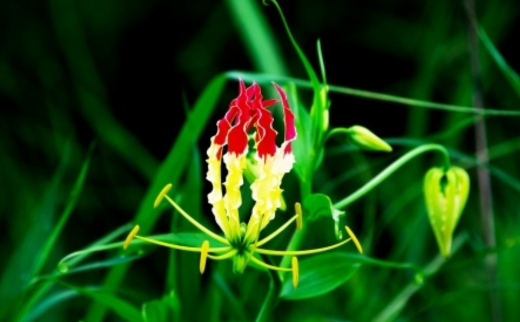Langali/ Kalihari/ Tiger’s Claws/ The Glory Lily/ Gloriosa superba Linn. – Ayurvedic Uses & Benefits
Abstract
Gloriosa superba, commonly known as flame lily, is a highly valued medicinal and ornamental plant with a distinctive climbing habit and striking, flame-like flowers. This plant is widely utilised in traditional medicinal systems like Ayurveda, Siddha and Unani for its potent therapeutic properties. Its bioactive compounds, especially colchicine, have shown promising pharmacological effects. Traditionally, it has been used in treating inflammation, gout, infertility, and parasitic infections. However, due to its toxic nature, proper dosage and medical supervision are crucial. This article explores the plant’s classical significance and its wide range of medicinal applications.

Introduction
It is known for its aesthetic beauty and potent medicinal value. Gloriosa superba holds an important place in ethnomedicine across Africa and Asia. It has been used since ancient times for a range of ailments, including skin diseases, arthritis and snake bites. Despite its therapeutic relevance, the plant is considered toxic if used improperly, necessitating caution in its administration. Its tubers and seeds are rich in alkaloids like colchicine, contributing to its biological actions. Due to overharvesting and habitat destruction, Gloriosa superba is now considered threatened in several regions. Its cultivation and conservation are therefore essential to preserve its medicinal legacy.
Scientific Classification
- Kingdom: Plantae
- Subkingdom: Tracheobionta
- Division: Magnoliophyta
- Class: Liliopsida
- Order: Liliales
- Family: Colchicaceae
- Genus: Gloriosa
- Species: Gloriosa superba Linn.
Synonyms
- Agnishikha – The flowers are bright red, resembling fire.
- Raktapushpa – The flowers are red like blood.
- Garbapatini / Garbanuth – The herb is known for its abortifacient property; it expels the fetus.
- Halini – The tuber resembles the shape of a plough.
- Shukrapushpi / Indrapushpi – Refers to the plant’s beautiful and attractive flowers.
- Vahnijihva / Vahni Vaktra / Pradeepta / Vahnimukhi / Agnishikha – All denote the flame-like appearance of the flowers.
- Kalihari – Indicates its utility in surgical or emergency medical conditions.
- Siri
- Vishalya
- Kalikari
- Prabhata
- Pushpaseebhara
Vernacular Names
- Hindi name – Kalihari
- English names – Malabar Glory Lily, Tiger’s Claw, Climbing Lily
- Bengali name – Ulatchandal
- Marathi name – Kalalavi
- Tamil name – Kalai Pai
- Sanskrit – Sukrapushpika, Garbhagatini, Langalika, Agnishikha, Kalikari, Vishalya, Ailini, Agnimukhi, Langli
- Punjabi – Mulim, Kariari
- Telugu – Adavinabhi, Agnishikha, Kalappa-gadda, Pottidumpa, Ganjeri
- Tulu – Balipapu, Kenakannadapu
- Kannada – Agnishike, Nangulika
- Persian – Bachnack
- Malayalam – Manthori-kizhangu, Macttoennui, Kandal, Ventoni, Mettoni, Kithonn
- Gujarati – Khadyanag, Dudhio, Vacchonag
- Marathi – Indai, Karadi, Karianag
- Oriya – Ognishikha, Garbhhoghhatono, Panjangulia, Meheriaphulo
- French – Lis de Malabar, Lis grimpant, Lis glorieux
- Portuguese – Garras de Tigre, Aranha de Emposse
- Swahili – Mkalamu, Kimanjanouchawi
- Sinhalese – Neyaangalla, Niyangalla
- Burmese – Simadon, Hseemeetouk
- Canarese – Agnisikhe, Akkatangaballi, Huliyuguru, Nangulika, Kolikutuma
- Javanese (Java) – Akarsoengsang
- Urdu – Kulhar, Kanol
- Lushkar – Husangibdo, Merkam-par
- Kano (Nigeria) – Gudumarzomo
- Deccan – Naktabachhnag
Habitat
Gloriosa superba is widely distributed across tropical and subtropical regions of Africa and Southeast Asia, including countries like India, Myanmar, Sri Lanka, and Malaysia. In Africa, its presence extends across nations such as Senegal, Somalia, South Africa, and Zambia. Within India, the plant is found in various states including Himachal Pradesh, Jammu & Kashmir, Haryana, West Bengal, Uttar Pradesh, Maharashtra, Chhattisgarh, Odisha, Andhra Pradesh, Karnataka, Kerala, Goa, and Tamil Nadu. Notably, it is recognised as the national flower of Zimbabwe and Tamil Eelam, and serves as the state flower of Tamil Nadu in India.
Morphology
Gloriosa superba is a strikingly beautiful, semi-woody, herbaceous perennial climber that can reach up to 6 meters in height. It grows annually from a tuberous underground stem during the rainy season. The plant thrives in diverse habitats such as riverbanks, savannah woodlands, grasslands, dunes, and semi-evergreen forests, and is highly tolerant of nutrient-poor, sandy-loam soils. It is commonly associated with species like Prosopis juliflora and Borassus flabellifer, particularly in Tamil Nadu. The climbing stem bears alternate, opposite, or whorled leaves that are ovate-lanceolate with a prominent midrib, ending in a spiral tendril. The flowers are large, axillary or solitary, with six reflexed, wavy-margined petals and six versatile stamens. The ovary is three-celled with multiple ovules, and the fruit is an ellipsoid, leathery capsule containing spongy, subglobose seeds with a cylindrical embryo.
Special Note
Langli is also a name used for Kewach. Some people mistakenly consider Costus speciosus (Koen.) Sm. as Langli, which is actually Kemuk. In the Varanasi market, its tuber pieces are sold as Kalihari. Comparative study in animals has shown that Kemuk has more uterine contracting activity than the real Kalihari.
Classical Categorisation
- According to Bhavaprakash Nighantu – Guduchyadi Varga
- According to Dhanvantari Nighantu – Karaveeradi Varga
- According to Kaiyadeva Nighantu – Aushadhi Varga
Ancient Verses
कलिहारी सरा कुष्ठशोफार्शीव्रणशूलजित् ॥
सक्षारा श्लेष्मजित्तिक्ता कटुका तुवराऽपि च ।
तीक्ष्णोष्णा कृमिहललध्वी पित्तला गर्भपातिनी ॥
According to the above shloka, Kalihari has hot potency, bitter, pungent and astringent taste, light in nature and balances Kapha dosha. It is effective in the management of constipation, leprosy, inflammation, haemorrhoids, wounds, worm infestation and pain. It increases Pitta dosha and contains alkaline properties. It causes abortion.
Ayurvedic Properties
- Taste (Rasa): Bitter (Tikta), Pungent (Katu), Astringent (Kashaya)
- Physical Property (Guna): Light (Laghu)
- Potency (Veerya): Hot Potency (Usna)
- Post-digestion Effect (Vipaka): Katu (Pungent)
- Effect on Tridosha: Balances Kapha dosha
Therapeutic Properties
- Appetiser: Stimulates digestion in medicinal doses
- Skin Disorders: Beneficial in various skin diseases, including leprosy
- Anti-venom: Used in cases of scorpion and snake bites
- Anthelmintic: Helps eliminate intestinal worms
- Anti-inflammatory: Effective in reducing swelling and oedema (Shotha)
- Wound Healing: Promotes healing of wounds (Vrana)
- Lymphadenitis: Useful in treating enlarged lymph nodes (Gandamala)
- Hair Tonic: Helps in managing hair fall (Khalitya)
- Purgative: Mild purgative action in small, safe doses
- Abortifacient: Used in delayed labour and expulsion of the placenta
- Antiperiodic: Used in fevers with periodic recurrence
- Joint Pain Relief: Alleviates arthritis and related disorders (Vatavyadhi)
- Piles (Aarsha): Used in the treatment of haemorrhoids
Systemic Actions
External Use
Langali is beneficial when applied externally for conditions such as swelling, haemorrhoids, wounds, cervical lymphadenopathy, skin ailments, and scorpion bites. It also exhibits anthelmintic and abortifacient properties. Traditionally, after childbirth, a paste of Langali stem is applied to the hands, legs, umbilical region, and lower abdomen to aid in placental expulsion. In earlier times, the stem was even inserted vaginally to assist in facilitating labor.
Internal Uses
- Digestive System: In small, therapeutic doses, Langali acts as a carminative and anthelmintic. However, if taken in excess, it may lead to nausea, vomiting, abdominal burning, and purgation. When carefully administered, it is useful in cases of poor digestion and intestinal worm infestations.
- Circulatory System: Works as a natural blood purifier and is especially recommended in the management of skin-related disorders.
- Reproductive System: It stimulates uterine contractions and is used in conditions like delayed labour. It should be avoided in pregnancy as it may cause an abortion. The powdered root may be prescribed in such cases under strict medical supervision.
- Tapakrama (Fever Management): Indicated in chronic and irregular fevers such as Vishamajvara (intermittent fevers).
- Satmikarana (Rejuvenation & Strength): When used in low doses, it supports overall vitality and helps in strengthening the body.
Chemical Composition
- Colchicine
- Gloriosine
- Superbine
- Chemitropic acid
- 3-demethyl colchicine
- Beta-lumicolchicine
- Cornigerine
- Luteolin
- Gloriosin
Modern Overview
Cytotoxic Activity
The potent cytotoxic activity of Gloriosa superba is primarily attributed to the presence of the alkaloid colchicine. Chloroform, methanol, and petroleum ether extracts of the plant have demonstrated significantly low ED₅₀ values against the P388 cell line, indicating strong cytotoxic potential likely due to the high colchicine content. Additionally, methanolic extracts of the tubers have shown notable cytotoxic effects on Hep-G2 liver cancer cell lines, with concentrations ranging from 5 to 100 µg/ml. At 100 µg/ml, the extract exhibited the highest inhibition rate, reaching 54.36% suppression of Hep-G2 cell growth.
Anti-inflammatory Activity
Gloriosa superba contains colchicine, a well-known alkaloid primarily responsible for its potent anti-inflammatory properties. Colchicine works by inhibiting microtubule polymerisation, thereby reducing the activity of neutrophils at sites of inflammation, making it particularly effective in the treatment of gout and other inflammatory conditions. In addition to colchicine, the plant contains other bioactive alkaloids such as gloriosine and superbine, which may contribute to its analgesic and therapeutic effects. These compounds are mainly concentrated in the tubers and seeds of the plant.
For Delayed Labour
Gloriosa superba, commonly known as Glory Lily or Langali, has been traditionally used in some tribal and folk medicine systems for inducing abortion and stimulating delayed labour. This effect is primarily attributed to its active chemical constituents, especially colchicine, along with other alkaloids such as gloriosine and superbine. Colchicine is a powerful cytotoxic compound that disrupts cell division and can stimulate uterine contractions, leading to the expulsion of the uterine contents. Because of this uterotonic action, preparations made from the tubers or seeds of the plant were sometimes used to terminate early pregnancies or induce labour in cases of delay.
Practical Uses
- The rhizome paste of Langali is used externally in the treatment of scorpion bites, bee stings, and centipede bites.
- Paste made from the rhizome of Gloriosa superba is applied locally to areas affected by skin disorders, external haemorrhoids, wounds, and joint swellings.
- To induce abortion, Langali paste is applied over the umbilical region or administered internally, as it helps stimulate uterine contractions.
- The fresh juice extracted from the leaves of Langali is applied to the scalp to eliminate head lice.
- In a dose of 250–500 mg, the powdered rhizome mixed with milk is consumed to promote body strength and vitality.
- A dose of 500–750 mg of Langali powder taken with hot water is recommended for treating intestinal worm infestations.
- For managing fever and enhancing appetite, 1–1.5 g of rhizome powder is administered internally.
Part Used
Tuber
Dosage
Powder – 125–250 mg
Ayurvedic Medicines
- Kasisadi Oil
- Langali Rasayan
Planet Ayurveda Medicines
Conclusion
Gloriosa superba stands as a remarkable medicinal plant that embodies both healing potential and toxic danger. Its potent alkaloids, especially colchicine, make it a powerful agent in treating inflammatory and parasitic conditions, yet also demand careful and expert handling. Traditional systems of medicine like Ayurveda have long recognised their therapeutic significance, employing them in a range of remedies for skin issues, arthritis and reproductive concerns. With increasing awareness of its endangered status, conservation and controlled cultivation are imperative. Used wisely and cautiously, Gloriosa superba continues to offer promising avenues in both traditional and modern medicine.



